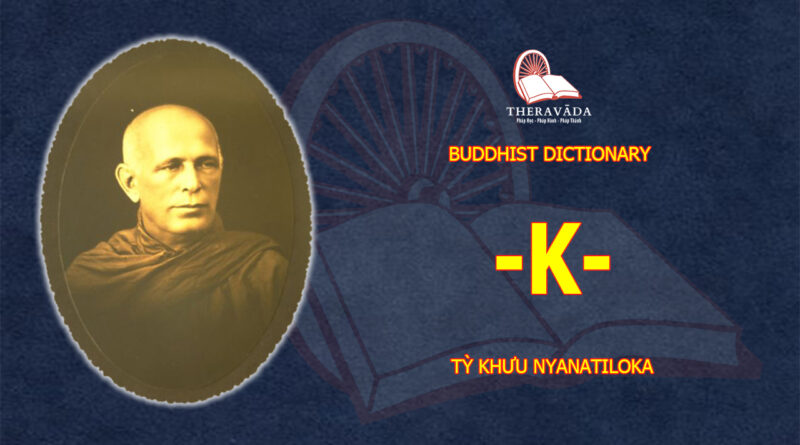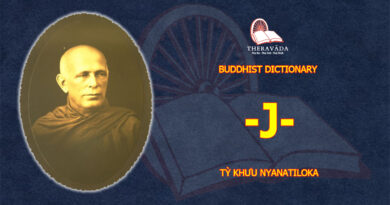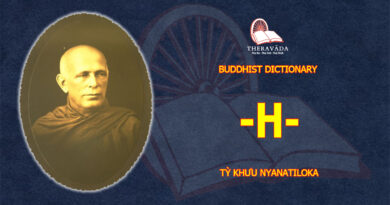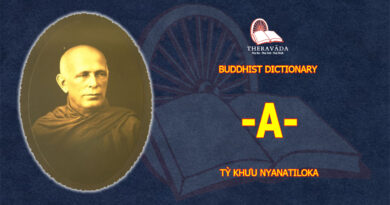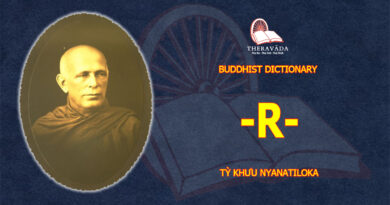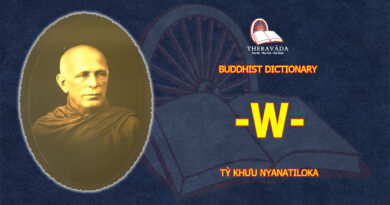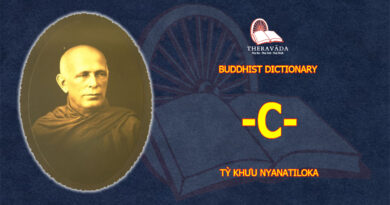BUDDHIST DICTIONARY
-K-
kabalinkārāhāra: lit. ‘food formed into balls’, i.e. food formed into mouthfuls for eating (according to Indian custom); it denotes ‘material food’ and belongs, together with the three mental nutriments, to the group of four nutriments (s. āhāra).
kalāpa, ‘group’, ‘unit’: 1. ‘corporeal unit’ (s. rūpa-kalāpa); 2. It has the meaning of ‘group of existence’ (khandha) in kalāpasammasana (s. sammasana), i.e. ‘comprehension by groups’, which is the application of ‘methodical (or inductive) insight’ (naya-vipassanā) to the comprehension of the 5 aggregates (khandha) as impermanent, painful and not-self. It is a process of methodical summarization, or generalization, from one’s own meditative experience that is applied to each of the 5 aggregates, viewed as past, present, future, as internal and external, etc. In Vis.M. XX, where the ‘comprehension by groups’ is treated in detail, it is said to constitute ‘the beginning of insight’ as it leads to the ‘knowledge of rise and fall’, being the first of the 8 insightknowledges (s. visuddhi VI). It is necessary for accomplishing the 5th purification (s. visuddhi V; Vis.M. XX, 2, 6ff.).
kappa (q.v.) = kalpa: (Skr).
kalyāna-mitta: ‘noble (or good) friend’, is called a senior monk who is the mentor and friend of his pupil, “wishing for his welfare and concerned with his progress”, guiding his meditation; in particular, the meditation teacher (kammaṭṭhānācariya) is so called. For details see Vis.M. III, 28,57ff. The Buddha said that “noble friendship is the entire holy life” (S. III, 18; XLV, 2), and he himself is the good friend par excellence: “Ānanda, it is owing to my being a good friend to them that living beings subject to birth are freed from birth” (S. III, 18).
kāma may denote: 1. subjective sensuality, ‘sense-desire’; 2. objective sensuality, the five sense-objects.
- Subjective sensuality, or sense-desire, is directed to all five sense-objects, and is synonymous with kāma-cchanda, ‘sensuous desire’, one of the 5 hindrances (nīvaraṇa, q.v.); kāma-rāga, sensuous lust’, one of the ten fetters (saṃyojana, q.v.); kāma-taṇhā, ‘sensuous craving’, one of the 3 cravings (taṇhā, q.v.); kāma-vitakka, ‘sensuous thought’, one of the 3 wrong thoughts (micchā-saṅkappa; s. vitakka). – Sense-desire is also one of the cankers (āsava, q.v.) and clingings (upādāna, q.v.).
- Objective sensuality is, in the canonical texts, mostly called kāma-guṇa, ‘cords (or strands) of sensuality’.
“There are 5 cords of sensuality: the visible objects, cognizable by eye-consciousness, that are desirable, cherished, pleasant, lovely, sensuous and alluring; the sounds … smells … tastes … bodily impressions cognizable by body-consciousness, that are desirable …. ” (D. 33; M. 13, 26, 59, 66).
These two kinds of kāma are called 1. kilesa–kāma, i.e. kāma as a mental defilement, 2. vatthu-kāma, i.e. kāma as the object-base of sensuality; first in MNid.. I, p. 1, and frequently in the commentaries.
Sense-desire is finally eliminated at the stage of the Non-Returner (Anāgāmī; s. ariya-puggala, saṃyojana).
The peril and misery of sense-desire is often described in the texts, e.g. in stirring similes at M. 22, 54, and in the ‘gradual instruction’ (s. ānupubbī-kathā). See further M. 13, 45, 75; Sn. v. 766ff.; Dhp. 186, 215.
The texts often stress the fact that what fetters man to the world of the senses are not the sense-organs nor the sense-objects but lustful desire (chandarāga). On this see A. VI, 63; S. XXXV, 122, 191. – (App.).
kāma-bhava: ‘sensuous existence’; s. bhava.
kāma-cchanda: ‘sensuous desire’, s. nīvaraṇa, chanda.
kāma-guṇa: s. kāma.
kāma-loka: ‘sensuous world’, s. loka.
kāma-rāga: ‘sensuous lust’, is one of the 10 fetters (saṃyojana, q .v .) .
kāmāsava: s: āsava.
kāma-sukh’allikānuyoga: ‘being addicted to sensual pleasures’, is one of the 2 extremes to be avoided by the monk; s. majjhima-paṭipadā.
kāma-taṇhā: ‘sensuous craving’; s. taṇhā.
kāmāvacara : ‘sensuous sphere’; s. avacara.
kāmesu-micchācāra: lit. ‘wrong or evil conduct with regard to sensual things’; ‘unlawful sexual intercourse’ refers to adultery, and to intercourse with minors or other persons under guardianship. The abstaining from this unlawful act is one of the 5 moral rules (s. sikkhāpada) binding upon all Buddhists. Through any other sexual act one does not become guilty of the above transgression, which is considered a great crime. The monk, however, has to observe perfect chastity.
In many Suttas (e.g. A.X., 176) we find the following explanation: “He avoids unlawful sexual intercourse, abstains from it. He has no intercourse with girls who are still under the protection of father or mother, brother, sister or relatives, nor with married women, nor female convicts, nor, lastly, with betrothed girls.”
kamma: (wholesome or unwholesome) action; s. kamma.
kamma-bhava: s. bhava, paṭiccasamuppāda.
kammaja-rūpa: ‘kamma-produced corporeality’; s. samuṭṭhāna.
kammaññatā: ‘adaptability’, i.e. of corporeality (rūpassa; s. khandha, Summary I), mental factors (kāya), and of consciousness (citta); cf. Tab. II.
kammanta, sammā–: ‘right action’; s. magga.
kamma-paccaya: ‘kamma as condition’; s. paccaya (13).
kamma-patha: ‘course of action’, is a name for the group of 10 kinds of either unwholesome or wholesome actions, viz.
- The tenfold unwholesome courses of action (akusala-kamma-patha):
3 bodily actions: killing, stealing, unlawful sexual intercourse;
4 verbal actions: lying, slandering, rude speech, foolish babble;
3 mental actions: covetousness, ill-will, evil views.
Unwholesome mental courses of action comprise only extreme forms of defiled thought: the greedy wish to appropriate others’ property, the hateful thought of harming others, and pernicious views. Milder forms of mental defilement are also unwholesome, but do not constitute ‘courses of action’.
- The tenfold wholesome course of action (kusala-kamma-patha):
3 bodily actions: avoidance of killing, stealing, unlawful sexual intercourse;
4 verbal actions: avoidance of lying, slandering, rude speech, foolish babble; i.e. true, conciliatory, mild, and wise speech;
3 mental actions: unselfishness, good-will, right views.
Both lists occur repeatedly, e.g. in A. X, 28, 176; M. 9; they are explained in detail in M. 114, and in Com. to M. 9 (R. Und., p. 14), Aṭṭhasālinī Tr. I, 126ff.
kamma-samuṭṭhāna-rūpa: ‘corporeality produced through kamma’; s. samuṭṭhāna.
kammaṭṭhāna: lit. ‘working-ground’ (i.e. for meditation), is the term in the Com. for ‘subjects of meditation’; s. bhāvanā.
kamma-vatta: ‘kamma-round’; s. vatta.
kammāyūhana: s. āyūhana.
kāmupādāna: ‘sensuous clinging’, is one of the 4 kinds of clinging (upādāna, q.v.).
kaṅkhā: ‘doubt’, may be either an intellectual, critical doubt or an ethically and psychologically detrimental doubt. The latter may either be a persistent negative skepticism or wavering indecision. Only the detrimental doubt (identical with vicikicchā , q.v.) is to be rejected as kammically unwholesome, as it paralyses thinking and hinders the inner development of man. Reasoned, critical doubt in dubious matters is thereby not discouraged.
The 16 doubts enumerated in the Suttas (e.g. M. 2) are the following: “Have I been in the past? Or, have I not been in the past? What have I been in the past? How have I been in the past? From what state into what state did I change in the past? – Shall I be in the future? Or, shall I not be in the future? What shall I be in the future? How shall I be in the future? From what state into what state shall I change in the future? – Am I? Or, am I not? What am I? How am I? Whence has this being come? Whither will it go?”
kaṅkhā-vitarana-visuddhi: ‘purification by overcoming doubt’, is the 4th of the 7 stages of purification (visuddhi, q.v.).
kappa (Sanskrit kalpa): ‘world-period’, an inconceivably long space of time, an aeon. This again is subdivided into 4 sections: world-dissolution (saṃvaṭṭa-kappa) dissolving world), continuation of the chaos (saṃvaṭṭa-ṭṭhāyī), world-formation (vivaṭṭa -kappa), continuation of the formed world (vivaṭṭa-ṭṭhāyī).
“How long a world-dissolution will continue, how long the chaos, how long the formation, how long the continuation of the formed world, of these things; o monks, one hardly can say that it will be so many years, or so many centuries, or so many millennia, or so many hundred thousands of years” (A. IV, 156)
A detailed description of the 4 world-periods is given in that stirring discourse on the all-embracing impermanence in A. VII, 62.
The beautiful simile in S. XV, 5 may be mentioned here: “Suppose, o monks, there was a huge rock of one solid mass, one mile long, one mile wide, one mile high, without split or flaw. And at the end of every hundred years a man should come and rub against it once with a silken cloth. Then that huge rock would wear off and disappear quicker than a world-period. But of such world-periods, o monks, many have passed away, many hundreds, many thousands, many hundred thousands. And how is this possible? Inconceivable, o monks, is this saṃsāra (q.v.), not to be discovered is any first beginning of beings, who obstructed by ignorance and ensnared by craving, are hurrying and hastening through this round of rebirths.”
Compare here Grimm’s German fairy-tale of the little shepherdboy: ‘In Farther Pommerania there is the diamond-mountain, one hour high, one hour wide, one hour deep. There every hundred years a little bird comes and whets its little beak on it. And when the whole mountain is ground off, then the first second of eternity has passed.”
kamma: (Sanskrit : karma): ‘action’, correctly speaking denotes the wholesome and unwholesome volitions (kusala– and akusala–cetanā) and their concomitant mental factors, causing rebirth and shaping the destiny of beings. These kammical volitions (kamma cetanā) become manifest as wholesome or unwholesome actions by body (kāya-kamma), speech (vacī-kamma) and mind (mano-kamma). Thus the Buddhist term ‘kamma’ by no means signifies the result of actions, and quite certainly not the fate of man, or perhaps even of whole nations (the so-called wholesale or mass-kamma), misconceptions which, through the influence of theosophy, have become widely spread in the West.
“Volition (cetanā), o monks, is what I call action (cetanāhaṃ bhikkhave kammaṃ vadāmi), for through volition one performs the action by body, speech or mind. . There is kamma (action), o monks, that ripens in hell…. Kamma that ripens in the animal world.. Kamma that ripens in the world of men…. Kamma that ripens in the heavenly world…. Threefold, however, is the fruit of kamma: ripening during the life-time (diṭṭha-dhamma-vedanīya kamma), ripening in the next birth (upapajja-vedanīya kamma), ripening in later births (aparāpariya-vedanīya kamma) ….” (A.VI, 63).
The 3 conditions or roots (mūla, q.v.) of unwholesome kamma (actions) are greed, hatred, delusion (lobha, dosa, moha); those of wholesome kamma are: unselfishness (alobha), hatelessness (adosa = mettā,good-will), undeludedness (amoha = paññā, knowledge) .
“Greed, o monks, is a condition for the arising of kamma; hatred is a condition for the arising of kamma; delusion is a condition for the arising of kamma ….” (A. III, 109).
“The unwholesome actions are of 3 kinds, conditioned by greed, or hate, or delusion.
“Killing … stealing … unlawful sexual intercourse … lying … slandering … rude speech … foolish babble, if practised, carried on, and frequently cultivated, leads to rebirth in hell, or amongst the animals, or amongst the ghosts” (A. III, 40). “He who kills and is cruel goes either to hell or, if reborn as man, will be short-lived. He who torments others will be afflicted with disease. The angry one will look ugly, the envious one will be without influence, the stingy one will be poor, the stubborn one will be of low descent, the indolent one will be without knowledge. In the contrary case, man will be reborn in heaven or reborn as man, he will be long-lived, possessed of beauty, influence, noble descent and knowledge” (cf. M. 135).
For the above 10-fold wholesome and unwholesome course of action, see kamma-patha. For the 5 heinous crimes with immediate result, s. ānantarika-kamma.
“Owners of their kamma are the beings, heirs of their kamma, their kamma is their womb from which they are born, their kamma is their friend, their refuge. Whatever kamma they perform, good or bad, thereof they will be the heirs” (M. 135).
With regard to the time of the taking place of the kamma-result (vipāka), one distinguishes, as mentioned above, 3 kinds of kamma:
- kamma ripening during the life-time (diṭṭha-dhamma-vedanīya kamma);
- kamma ripening in the next birth (upapajja-vedanīya kamma);
- kamma ripening in later births (aparāpariya-vedanīya kamma).
The first two kinds of kamma may be without kamma-result (vipāka), if the circumstances required for the taking place of the kamma-result are missing, or if, through the preponderance of counteractive kamma and their being too weak, they are unable to produce any result. In this case they are called ahosi-kamma, lit. ‘kamma that has been’, in other words, ineffectual kamma.
The third type of kamma, however, which bears fruit in later lives, will, whenever and wherever there is an opportunity, be productive of kamma-result. Before its result has ripened, it will never become ineffective as long as the life-process is kept going by craving and ignorance.
According to the Com., e.g. Vis.M. XIX, the 1st of the 7 kammical impulsive-moments (kamma-javana; s. javana) is considered as ‘kamma ripening during the life-time’, the 7th moment as ‘kamma ripening in the next birth’, the remaining 5 moments as ‘kamma ripening in later births’.
With regard to their functions one distinguishes:
- regenerative (or productive) kamma (janaka-kamma),
- supportive (or consolidating) kamma (upatthambhaka kamma),
- counteractive (suppressive or frustrating) kamma (upapīḷaka kamma),
- destructive (or supplanting) kamma (upaghātaka- or upacchedaka kamma).
(1) produces the 5 groups of existence (corporeality, feeling, perception, mental formations, consciousness) at rebirth as well as during life-continuity.
(2) does not produce kamma-results but is only able to maintain the already produced kamma-results.
(3) counteracts or suppresses the kamma-results.
(4) destroys the influence of a weaker kamma and effects only its own result.
With regard to the priority of their result one distinguishes:
- weighty kamma (garuka kamma),
- habitual kamma (āciṇṇaka- or bahula-kamma),
- death-proximate kamma (maraṇāsanna kamma),
- stored-up kamma (kaṭattākamma).
(1, 2) The weighty (garuka) and the habitual (bahula) wholesome or unwholesome kamma are ripening earlier than the light and rarely performed kamma. (3) The death-proximate (maraṇāsanna) kamma – i.e. the wholesome or unwholesome volition present immediately before death, which often may be the reflex of some previously performed good or evil action (kamma), or of a sign of it (kamma–nimitta), or of a sign of the future existence (gati-nimitta) – produces rebirth. (4) In the absence of any of these three actions at the moment before death, the stored-up (katattā) kamma will produce rebirth.
A real, and in the ultimate sense true, understanding of Buddhist kamma doctrine is possible only through a deep insight into the impersonality (s. anattā) and conditionality (s. paṭiccasamuppāda, paccaya) of all phenomena of existence. “Everywhere, in all the forms of existence … such a one is beholding merely mental and physical phenomena kept going by their being bound up through causes and effects.
“No doer does he see behind the deeds, no recipient apart from the kamma-fruit. And with full insight he clearly understands that the wise ones are using merely conventional terms when, with regard to the taking place of any action, they speak of a doer, or when they speak of a receiver of the kamma-results at their arising. Therefore the ancient masters have said:
‘No doer of the deeds is found,
No one who ever reaps their fruits;
Empty phenomena roll on:
This view alone is right and true.
‘And whilst the deeds and their results
Roll on, based on conditions all,
There no beginning can be seen,
Just as it is with seed and tree.’ ” (Vis.M. XIX)
Kamma (kamma-paccaya) is one of the 24 conditions (paccaya, q.v.) (App.: Kamma).
Literature: Kamma and Rebirth, by Nyanatiloka (WHEEL 9); Survival and Kamma in Buddhist Perspective, by K.N. Jayatilleke (WHEEL 141/143); Kamma and its Fruit (WHEEL 221/224).
kamma-accumulation: āyūhana (q.v.).
kamma-formations: saṅkhāra, i.e. wholesome or unwholesome volitions (cetanā) manifested as actions of body, speech or mind, form the 2nd link of the formula of dependent origination(paṭiccasamuppāda, q.v.).
kamma-process: s. bhava, paṭiccasamuppāda.
kamma-produced corporeality: s. samuṭṭhāna.
kamma-result: vipāka (q.v.).
kamma-round: kamma vatta (s. vatta).
kammically acquired corporeality: upādinnarūpa (q.v.).
kammically wholesome, unwholesome, neutral: kusala (q.v.), akusala(q.v.) avyākata (q.v.); cf. Tab. I.. .
karunā: ‘compassion’, is one of the 4 sublime abodes (brahma-vihāra, q.v.).
kasiṇa: (perhaps related to Sanskrit krtsna, ‘all, complete, whole’), is the name for a purely external device to produce and develop concentration of mind and attain the 4 absorptions (jhāna q.v.). It consists in concentrating one’s full and undivided attention on one visible object as preparatory image (parikamma-nimitta), e.g. a colored spot or disc, or a piece of earth, or a pond at some distance, etc., until at last one perceives, even with the eyes closed, a mental reflex, the acquired image (uggaha-nimitta). Now, while continuing to direct one’s attention to this image, there may arise the spotless and immovable counter-image (paṭibhāga-nimitta), and together with it the neighbourhood-concentration (upacāra-samādhi) will have been reached. While still persevering in the concentration on the object, one finally will reach a state of mind where all sense-activity is suspended, where there is no more seeing and hearing, no more perception of bodily impression and feeling, i.e. the state of the 1st mental absorption (jhāna,q.v.).
The 10 kasiṇas mentioned in the Suttas are: earth-kasiṇa, water, fire, wind, blue, yellow, red, white, space, and consciousness. “There are 10 kasiṇa-spheres: someone sees the earth kasiṇa, above, below, on all sides, undivided, unbounded …. someone see the water-kasiṇa, above, below, etc.” (M. 77; D. 33) Cf. abhibhāyatan, bhāvanā; further s. Fund. IV.
For space and consciousness-kasiṇa we find in Vis.M. V the names limited space-kasiṇa (paricchinnākāsa-kasiṇa; . . . s. App. ) and light-kasiṇa (āloka-kasiṇa).
For full description see Vis.M. IV-V; also Aṭṭhasālinī Tr. I, 248.
kaṭattākamma: ‘stored-up kamma’; s. kamma.
kāya (lit: accumulation): ‘group’, ‘body’, may either refer to the physical body (rūpa-kāya) or to the mental body (nāma-kāya). In the latter case it is either a collective name for the mental groups (feeling, perception, mental formations, consciousness; s. khandha), or merely for feeling, perception and a few of the mental formations (s. nāma), e.g. in kāya-lahutā, etc. (cf. Tab. II). Kāya has this same meaning in the standard description of the 3rd absorption (jhāna, q.v.) “and he feels joy in his mind or his mental constitution (kāya)”, and (e.g. Pug. 1-8) of the attainment of the 8 deliverances (vimokkha, q.v.); “having attained the 8 deliverances in his mind, or his person (kāya).” – Kāya is also the 5th sense-organ, the body-organ; s. āyatana, dhātu, indriya.
kāya-gatā-sati: ‘mindfulness with regard to the body’, refers sometimes (e.g. Vis.M. VIII, 2) only to the contemplation on the 32 parts of the body, sometimes (e.g. M. 119) to all the various meditations comprised under the ‘contemplation of the body’ (kāyānupassanā), the 1st of the 4 ‘foundations of mindfulness’ (Satipaṭṭhāna, q.v.), consisting partly in concentration (samādhi) exercises, partly in insight (vipassanā) exercises. On the other hand, the cemetery meditations (sīvathika, q.v.) mentioned in the Satipaṭṭhāna S.(M. 10) are nearly the same as the 10 contemplations of loathsomeness (asubha-bhāvanā, q.v.). of Vis.M. VI, whereas elsewhere the contemplation on the 32 parts of the body is called the ‘reflection on impurity’ (paṭikkūla-saññā).
In such texts as: ‘One thing, o monks, developed and repeatedly practised, leads to the attainment of wisdom. It is the contemplation on the body’ (A.I), the reference is to all exercises mentioned in the 1st Satipaṭṭhāna.
Vis.M. VIII, 2 gives a detailed description and explanation of the method of developing the contemplation on the 32 parts of the body. This exercise can produce the 1st absorption only (jhāna, q.v.) The stereotype text given in the Satipaṭṭhāna Sutta and elsewhere – but leaving out the brain – runs as follows:
“And further, o monks, the monk contemplates this body from the soles of the feet upward, and from the tops of the hairs downward, with skin stretched over it, and filled with manifold impurities: ‘This body has hairs of the head, hairs of the body, nails, teeth, skin, flesh, sinews, bones, marrow, kidneys, heart, liver, diaphragm, spleen, lungs, intestines, bowels, stomach, excrement, bile, phlegm, pus, blood, sweat, fat, tears, skin grease, spittle, nasal mucus, oil of the joints, and urine ….”
Vis.M. VIII, 2 says “By repeating the words of this exercise one will become well acquainted with the wording, the mind will not rush here and there, the different parts will become distinct and appear like a row of fingers, or a row of hedge-poles. Now, just as one repeats the exercise in words, one should do it also in mind. The repeating in mind forms the condition for the penetration of the characteristic marks…. He who thus has examined the parts of the body as to colour, shape, region, locality and limits, and considers them one by one, and not too hurriedly, as something loathsome, to such a one, while contemplating the body, all these things at the same time are appearing distinctly clear. But also when keeping one’s attention fixed outwardly (i.e. to the bodies of other beings), and when all the parts appear distinctly, then all men and animals moving about lose the appearance of living beings and appear like heaps of many different things. And it looks as if those foods and drinks, being swallowed by them, were being inserted into this heap of things. Now, while again and again one is conceiving the idea ‘Disgusting! Disgusting!’ – omitting in due course several parts – gradually the attainment – concentration (appanā-samādhi, i.e. the concentration of the jhāna) will be reached. In this connection, the appearing of forms … is called the acquired image (uggaha-nimitta), the arising of loathsomeness, however, the counter-image (paṭibhāga-nimitta).“
kāya-kamma: ‘bodily action’; s. kamma, kammapatha.
kāya-kammaññatā, k.–lahutā, k.–mudutā, k.–pāguññatā, k.–passaddhi, k.–ujukatā ; s. Tab. II. For passaddhi, s. further bojjhaṅga.
kāya-lahutā: agility or lightness of mental factors (s. lahutā).
kāyānupassanā: ‘contemplation of the body’, is one of the 4 foundations of mindfulness; s. Satipaṭṭhāna.
kāya-passaddhi: tranquillity of mental factors, s. bojjhaṅga.
kāya-sakkhi: ‘body-witness’, is one of the 7 noble disciples (s. ariya-puggala, B.). He is one who “in his own person (lit. body) has attained the 8 deliverances (vimokkha, q.v.), and after wisely understanding the phenomena, the cankers have partly come to extinction” (Pug. 32). In A. IX, 44 it is said: “A monk, o brother, attains the 1st absorption (jhāna, q.v.), and as far as this domain reaches,- so far he has realized it in his own person. Thus the Blessed One calls such a person a body-witness in certain respects. (The same is then repeated with regard to the 7 higher absorptions). Further again, o brother, the monk attains the extinction of perception and feeling (s. nirodha-samāpatti), and after wisely understanding the phenomena, all the cankers come to extinction. Thus, o brother, the Blessed One calls such a person a body-witness in all respects.”
kāya-viññatti: s. viññatti.
khalu-pacchā-bhattikaṅga: s. dhutaṅga.
khaṇa: ‘moment’; s. citta-kkhaṇa.
khandha: the 5 ‘groups (of existence)’ or ‘groups of clinging’ (upādānakkhandha); alternative renderings: aggregates, categories of clinging’s objects. These are the 5 aspects in which the Buddha has summed up all the physical and mental phenomena of existence, and which appear to the ignorant man as his ego, or personality, to wit:
(1) the corporeality group (rūpa-kkhandha),
(2) the feeling group (vedanā-kkhandha),
(3) the perception group (saññā-kkhandha),
(4) the mental-formation group (saṅkhāra-kkhandha),
(5) the consciousness-group (viññāṇa-kkhandha).
“Whatever there exists of corporeal things, whether past, present or future, one’s own or external, gross or subtle, lofty or low, far or near, all that belongs to the corporeality group. Whatever there exists of feeling … of perception … of mental formations … of consciousness … all that belongs to the consciousness-group” (S. XXII, 48). – Another division is that into the 2 groups: mind (2-5) and corporeality (1) (nāma-rūpa), whilst in Dhammasaṅganī, the first book of the Abhidhamma, all the phenomena are treated by way of 3 groups: consciousness (5), mental factors (2-4), corporeality (1), in Pāḷi citta, cetasika, rūpa. Cf. Guide I.
What is called individual existence is in reality nothing but a mere process of those mental and physical phenomena, a process that since time immemorial has been going on, and that also after death will still continue for unthinkably long periods of time. These 5 groups, however, neither singly nor collectively constitute any self-dependent real ego-entity, or personality (attā), nor is there to be found any such entity apart from them. Hence the belief in such an ego-entity or personality, as real in the ultimate sense, proves a mere illusion.
“When all constituent parts are there,
The designation ‘cart’ is used;
Just so, where the five groups exist,
Of ‘living being’ do we speak.” (S. V. 10).
The fact ought to be emphasized here that these 5 groups, correctly speaking, merely form an abstract classification by the Buddha, but that they as such, i.e. as just these 5 complete groups, have no real existence, since only single representatives of these groups, mostly variable, can arise with any state of consciousness. For example, with one and the same unit of consciousness only one single kind of feeling, say joy or sorrow, can be associated and never more than one. Similarly, two different perceptions cannot arise at the same moment. Also, of the various kinds of sense-cognition or consciousness, only one can be present at a time, for example, seeing, hearing or inner consciousness, etc. Of the 50 mental formations, however, a smaller or larger number are always associated with every state of consciousness, as we shall see later on.
Some writers on Buddhism who have not understood that the five khandha are just classificatory groupings, have conceived them as compact entities (‘heaps’, ‘bundles’), while actually, as stated above, the groups never exist as such, i.e. they never occur in a simultaneous totality of all their constituents. Also those single constituents of a group which are present in any given body- and -mind process, are of an evanescent nature, and so also their varying combinations. Feeling, perception and mental formations are only different aspects and functions of a single unit of consciousness. They are to consciousness what redness, softness, sweetness, etc. are to an apple and have as little separate existence as those qualities.
In S. XXII, 56, there is the following short definition of these 5 groups:
“What, o monks, is the corporeality-group? The 4 primary elements (Mahā-bhūta or dhātu) and corporeality depending thereon, this is called the corporeality-group.
“What, o monks, is the feeling-group? There are 6 classes of feeling: due to visual impression, to sound impression, to odour impression, to taste impression, to bodily impression, and to mind impression….
“What, o monks, is the perception-group? There are 6 classes of perception: perception of visual objects, of sounds, of odours, of tastes, of bodily impressions, and of mental impressions….
“What, o monks, is the group of mental formations? There are 6 classes of volitional states (cetanā): with regard to visual objects, to sounds, to odours, to tastes, to bodily impressions and to mind objects….
“What, o monks, is the consciousness-group? There are 6 classes of consciousness: eye-consciousness, ear-consciousness, nose-consciousness, tongue-consciousness, body-consciousness, and mind-consciousness.”
About the inseparability of the groups it is said:
”Whatever, o brother, there exists of feeling, of perception and of mental formations, these things are associated, not dissociated, and it is impossible to separate one from the other and show their difference. For whatever one feels, one perceives; and whatever one perceives, of this one is conscious” (M. 43).
Further: “Impossible is it for anyone to explain the passing out of one existence and the entering into a new existence, or the growth, increase and development of consciousness independent of corporeality, feeling, perception and mental formations” (S. XII, 53)
For the inseparability and mutual conditionality of the 4 mental groups s. paccaya (6, 7).
Regarding the impersonality (anattā) and emptiness (suññatā) of the 5 groups, it is said in S. XXII, 49:
“Whatever there is of corporeality, feeling, perception, mental formations and consciousness, whether past, present or future, one’s own or external, gross or subtle, lofty or low, far or near, this one should understand according to reality and true wisdom: ‘This does not belong to me, this am I not, this is not my Ego.’ “
Further in S. XXII, 95: “Suppose that a man who is not blind were to behold the many bubbles on the Ganges as they are driving along; and he should watch them and carefully examine them. After carefully examining them, however, they will appear to him empty, unreal and unsubstantial. In exactly the same way does the monk behold all the corporeal phenomena … feelings … perceptions … mental formations … states of consciousness, whether they be of the past, present or future … far or near. And he watches them and examines them carefully; and after carefully examining them, they appear to him empty, unreal and unsubstantial.”
The 5 groups are compared, respectively, to a lump of froth, a bubble, a mirage, a coreless plantain stem, and a conjuring trick (S. XXII, 95).
See the Khandha Saṃyutta (S. XXII); Vis.M. XIV.
SUMMARY OF THE 5 GROUPS
- Corporeality Group
(rūpa-kkhandha)
- Underived (no-upādā): 4 elements
the solid, or earth-element (paṭhavī-dhātu)
the liquid, or water-element (āpo-dhātu)
heat, or fire-element (tejo-dhātu)
motion, or wind-element (vāyo-dhātu)
- Derived (upādā): 24 secondary phenomena
Physical sense-organs of: seeing, hearing, smelling, tasting, body
Physical sense-objects: form, sound, odour, taste, (bodily impacts)
‘Bodily impacts’ (phoṭṭhabba) are generally omitted in this list, because these physical objects of body-sensitivity are identical with the afore-mentioned solid element, heat and motion element. Hence their inclusion under ‘derived corporeality’ would be a duplication.
femininity (itthindriya)
virility (purisindriya)
physical base of mind (hadaya–vatthu, q.v.)
bodily expression (kāya-viññatti; s. viññatti)
verbal expression (vacī-viññatti)
physical life (rūpa jīvita; s. jīvita)
space element (ākāsa-dhātu, q.v.)
physical agility (rūpassa lahutā)
physical elasticity (rūpassa mudutā)
physical adaptability (rūpassa kammaññatā)
physical growth (rūpassa upacaya)
physical continuity (rūpassa santati; s. santāna)
decay (jarā, q.v.)
impermanence (aniccatā)
nutriment (āhāra, q.v.)
- Feeling Group
(vedanā-kkhandha)
All feelings may, according to their nature, be classified as 5 kinds:
bodily agreeable feeling sukha = kāyikā sukhā vedanā
bodily painful feeling dukkha = kāyikā dukkhā vedanā
mentally agreeable feeling somanassa = cetasikā sukhā vedanā
mentally painful feeling domanassa = cetasikā dukkhā vedanā
indifferent feeling upekkhā = adukkha-m-asukhā vedanā
III. Perception Group
(saññā-kkhandha)
All perceptions are divided into 6 classes: perception of form, sound, odour, taste, bodily impression, and mental impression.
- Group of Mental Formations
(saṅkhāra-kkhandha)
This group comprises 50 mental phenomena, of which 11 are general psychological elements, 25 lofty (Sobhana) qualities, 14 kammically unwholesome qualities. Cf. Tab. 11.
- Consciousness Group
(viññāṇa-kkhandha)
The Suttas divide consciousness, according to the senses, into 6 classes: eye-, ear-, nose-, tongue-, body-, mind-consciousness.
The Abhidhamma and commentaries, however, distinguish, from the kammical or moral viewpoint, 89 classes of consciousness. Cf. viññāṇa and Tab. 1.
The moral quality of feeling, perception and consciousness is determined by the mental formations.
khandha-parinibbāna: s. Nibbāna.
khandha-santāna: s. santāna.
khanti : ‘patience’, forbearance’, is one of the 10 perfections (pāramī, q.v.).
khayānupassanā: ‘contemplation of dissolution’, is one of the 18 chief kinds of insight (s. vipassanā).
khidda-padosikā devā: ‘the celestial beings corruptible by pleasures’, are a class of devas (q.v.) of the sensuous sphere. They waste their time in merriment, play and enjoyment, and thereby become thoughtless, and in their thoughtlessness they fall from that world (D. 1; 24).
khīnāsava: ‘the one in whom all cankers are destroyed’ is a name for the Arahat, or Holy One; s. āsava.
kicca ‘function’. Regarding the 14 functions of consciousness, s. viññāṇa-kicca.
kilesa: ‘defilements’, are mind-defiling, unwholesome qualities. Vis.M. XXII, 49, 65: “There are 10 defilements, thus called because they are themselves defiled, and because they defile the mental factors associated with them. They are: (1) greed (lobha), (2) hate (dosa), (3) delusion (moha), (4) conceit (māna), (5) speculative views (diṭṭhi), (6) skeptical doubt (vicikicchā ), (7) mental torpor (thīna), (8) restlessness (uddhacca); (9) shamelessness (ahirika ), (10) lack of moral dread or unconscientiousness (anottappa).” For 1-3, s. mūla; 4, s. māna; 5, s. diṭṭhi; 6-8, s. nīvaraṇa; 9 and 10, s. ahirika –anottappa.
The ten are explained in Dhs. 1229f and enumerated in Vibh. XII. No classification of the k. is found in the Suttas , though the term occurs quite often in them. For the related term, upakkilesa (q.v.; ‘impurities’) different lists are given – (App.).
kilesa-kāma: ‘sensuality considered as defilement’ (s. kilesa) might well be called ‘subjective sensuality’, in contradistinction to ‘objective sensuality’ (vatthu-kāma), i.e. the sensuous objects (kāma-guṇa). Cf. kāma.
kilesa-parinibbāna: s. Nibbāna (1).
killing: s. kamma, kammapatha, sikkhāpada.
kiñcana: ‘something’, i.e. something evil that sticks or adheres to character. ‘Evil appendant’, is a name for the 3 unwholesome roots (mūla). “There are 3 appendants: greed (lobha) is an appendant, hate (dosa) is an appendant, delusion (moha) is an appendant” (D. 33). ‘Freed from appendants’ (akiñcana) is a term for the perfectly Holy One (Arahat).
kiriya (or kriya)-citta: ‘functional consciousness’ or ‘kammically inoperative consciousness’, is a name for such states of consciousness as are neither kammically wholesome (kusala), nor unwholesome (akusala), nor kamma-results (vipāka); that is, they function independently of kamma. Thus are also called all those worldly mental states in the Arahat which are accompanied by 2 or 3 noble roots (greedlessness, hatelessness, undeludedness), being in the Arahat kammically neutral and corresponding to the kammically wholesome states of a non-Arahat (s. Tab. 1-8 and 73-89), as well as the rootless mirth-producing (hasituppāda) mind-consciousness-element of the Arahat (Tab. 72); further, that mind-element (mano-dhātu) which performs the function of advertence (āvajjana) to the sense object (Tab. 70), and that mind-consciousness-element (manoviññāṇa-dhātu) which performs the functions of deciding (voṭṭhapana) and advertence to the mental object (Tab. 71). The last-named 2 elements, of course, occur in all beings.
Together with kamma-resultant consciousness (vipāka) it belongs to the group of ‘kammically neutral consciousness’ (avyākata). See Tab. I (last column). – (App.).
knowledge: cf. paññā, ñāṇa, vijjā, vipassanā, abhiññā.
kolaṅkola: ‘passing from one noble family to another’, is the name for one of the 3 kinds of Sotāpanna (q.v.).
kiriya-citta = kiriya (q.v.).
kukkucca: lit. ‘wrongly-performed-ness’ (ku+krta+ya), i.e. scruples, remorse, uneasiness of conscience, worry, is one of the kammically unwholesome (akusala) mental faculties (Tab. II) which, whenever it arises, is associated with hateful (discontented) consciousness (Tab. I and III, 30, 31). It is the ‘repentance over wrong things done, and right things neglected’ (Com. to A. I). Restlessness and scruples (uddhacca-kukkucca), combined, are counted as one of the 5 mental hindrances (nīvaraṇa, q.v.).
kuppa-dhamma ‘liable to perturbation’, is one who has not yet attained full mastery over the absorptions. In Pug. 3 it is said: “What person is liable to perturbation? Such a person gains the attainments of the fine-material and immaterial sphere (s. avacara). But he does not gain them at his wish, nor without toil and exertion; and not at his wish as regards place, object and duration, does he enter them or arise from them. Thus it is well possible that in case of such a person, through negligence, the attainments will become perturbed. This person is liable to perturbation.”
kusala: ‘kammically wholesome’ or ‘profitable’, salutary, morally good, (skillful) Connotations of the term, according to Com. (Aṭṭhasālinī), are: of good health, blameless, productive of favourable kamma-result, skillful. It should be noted that Com. excludes the meaning ‘skillful’, when the term is applied to states of consciousness.
It is defined in M. 9 as the 10 wholesome courses of action (s. kammapatha). In psychological terms, ‘kammically wholesome’ are all those kammical volitions (kamma-cetanā) and the consciousness and mental factors associated therewith, which are accompanied by 2 or 3 wholesome roots (s. mūla), i.e. by greedlessness (alobha) and hatelessness (adosa), and in some cases also by non-delusion (amoha:wisdom, understanding). Such states of consciousness are regarded as ‘kammically wholesome’ as they are causes of favourable kamma results and contain the seeds of a happy destiny or rebirth. From this explanation, two facts should be noted: (1) it is volition that makes a state of consciousness, or an act, ‘good’ or ‘bad’; (2) the moral criterion in Buddhism is the presence or absence of the 3 wholesome or moral roots (s. mūla).
The above explanations refer to mundane (lokiya, q.v.) wholesome consciousness. Supermundane wholesome (lokuttara-kusala) states, i.e. the four paths of sanctity (s. ariyapuggala), have as results only the corresponding four fruitions; they do not constitute kamma, nor do they lead to rebirth, and this applies also to the good actions of an Arahat (Tab. I, 73-80) and his meditative states (Tab. 1, 81-89), which are all kammically inoperative (functional; s. kiriya).
Kusala belongs to a threefold division of all consciousness, as found in the Abhidhamma (Dhs.), into wholesome (kusala), unwholesome (akusala) and kammically neutral (avyākata), which is the first of the triads (tika) in the Abhidhamma schedule (mātikā); s. Guide, pp. 4ff., 12ff; Vis.M. XIV, 83ff.
kusala-kammapatha: ‘wholesome course of action’; s. kammapatha.
kusala-mūla: the ‘wholesome roots’ or ‘roots of wholesome action’, are greedlessness (alobha), hatelessness (adosa), and non-delusion (amoha; s. mūla). They are identical with kusala–hetu (s . paccaya, 1).
kusala-vipāka: the (mental) ‘kamma-result of wholesome kamma’ (s. kamma).

